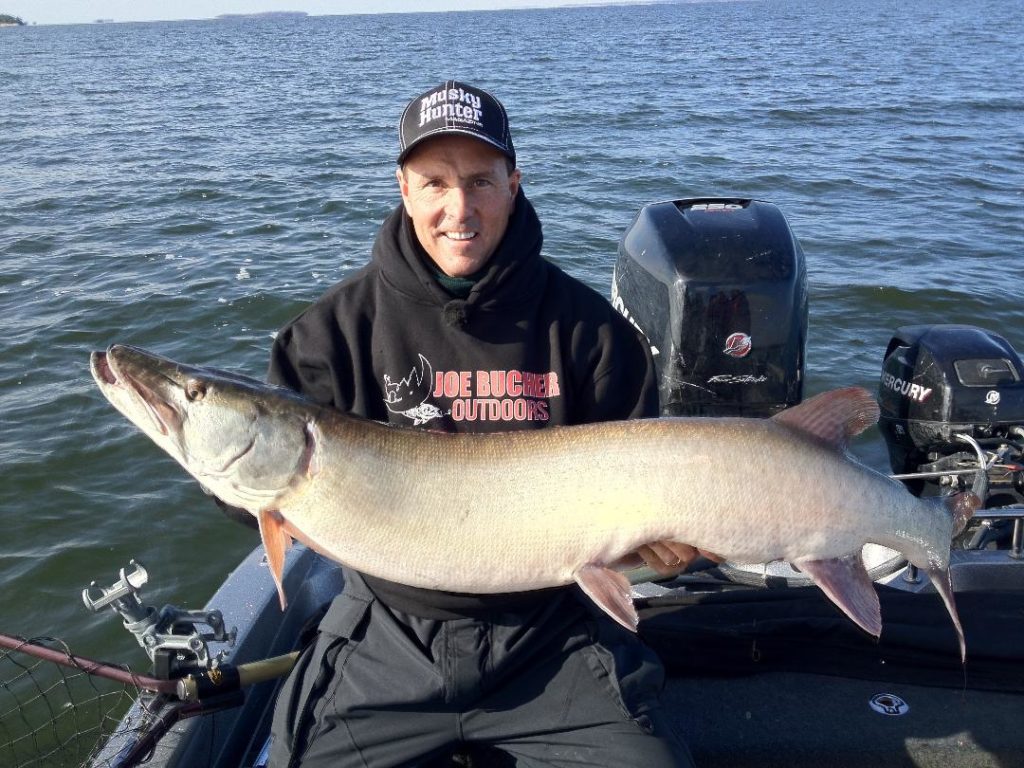THE FALL MIGRATION

It was a blustery and cold northwest wind. Every time we turned the boat into the wind the spray from a wave crashing into the side of the boat got someone wet, and ice crystals were beginning to form on the boat floor. It was a perfect late fall musky day! We had been trolling for hours with no results, but with conditions near perfect, and bait stacked up along the breakline we knew it was just a matter of time. After another hour the silence was interrupted with the screaming of the drag from the reel. Turning around it seemed like forever before we all realized which rod was pounding from the thunderous musky strike. Fortunately, it was my turn and I grabbed the rod. After sitting and driving the boat in the cold for several hours, my muscles were slow to respond to the change in motion and the battle was magnified. Initially, you always feel handicapped until your body catches up and adrenaline takes over. The fish stayed deep and the big waves amplified every headshake and kept my Shimano Sojourn rod doubled over. After a few minutes as the beast approached, my boat partner netted the giant. We took a few photographs and within a couple minutes the 52-inch beast was swimming away to fight again another day. Hi-fives were plentiful in the boat after that and another great fall memory was created.
That is fall musky fishing at its finest. As the water temperatures drop and freeze approaches, muskies make a fall migration towards their spawning areas and stage adjacent to them. Once located these areas can be musky magnets and each day can bring more muskies to the area. It seems as the water temperatures drop more fish tend to load into the spot. In theory, it should be pretty easy to locate and catch these concentrated groups of muskies, but that’s not always the case.
First, you need to locate the potential spawning areas. You can look are large shallow bays, adjacent to deep water, or large incoming creeks or rivers with flats in front of them as potential musky staging and spawning areas. This is when checking with your local department of natural resources can help. They are usually willing to point you in the direction of areas where muskies spawn. One thing to remember is that they don’t know all the spawning areas, so don’t ignore areas that appear to have spawning area and hold muskies.
Once you have located the spawning area, there’s really only two techniques I rely upon at this time, either troll the adjacent breakline or drop off, or cast giant pounder Bulldawgs. Pick your poison, but either can be effective. When fishing the breakline focus on the various subtle points and turns. Pay close attention to projections toward deep water or the inverse, which is an area where the deeper water swings tighter to the spawning area. Both of these scenarios are potential spots that may hold and concentrate muskies.
The next step is trying to get the muskies to bite and establish the depth of the day. With the water temperatures in the mid forties and colder the muskies aren’t doing a lot of moving, because they are finally near their wintering area adjacent to the spawning grounds. If there is significant bait in the area, they may stay in this area for a prolonged period. Their movement becomes more vertical in the water column to feed, during short feeding windows, rather than wandering everywhere to feed. Therefore, getting the muskies to bite can be difficult. This is why trolling is so effective at this time, as you simply always have a lure in the water. Keep trolling multiple depths and make multiple trolling passes in these staging areas. Once you catch a musky you have not only found the key depth, but may have located a precise spot where you can catch multiple muskies. The same approach holds true when casting large soft plastics. Try and determine if the muskies are located along the top, side or bottom of the breakline. Once established you can adjust your boat position to most effectively fish that depth. I have several lakes I fish in fall that have steep breaklines adjacent to a large flat that’s the size of a football field, and the majority of the muskies are caught from the same specific spots, every year. Your GPS waypoints are gold in late fall.
My top trolling lures at this time are straight model Depthraiders and 9 inch ShallowRaiders. Trolling speeds are slower in the 1.8 to 3 mph. As a general rule in stained water target depths of 12-18 feet and in clear water focus on depths of 15-28 feet.
In late fall you really can’t cover a lot of water with shorter days and short feeding windows. Fortunately, you don’t have to search far if you know where the spawning areas are located. Keep your baits in the water, keep experimenting and you’ll strike late fall gold.
